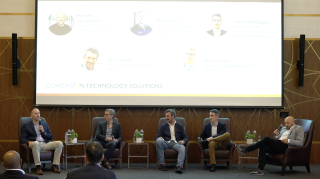The “Retro Look” For All The Wrong Reasons
March 6, 2019
The sheer quantity of quality video out there makes it a fantastic time to be an advertiser or agency. So many new devices, new audiences… the possibilities are literally becoming endless. Here’s the thing though: be it live streaming, linear, on-demand, broadcast, you name it – consumers are increasingly savvy about how premium video should look and sound like. Audiences are being trained every day to expect “the good stuff” from every device, and ad quality doesn’t get a free pass. In fact, it’s even more important: seen amidst a crisp, clear, high-definition program, a poor-quality ad looks even worse. When an ad break shifts from an HD or UHD program over to a commercial with quality that feels like a ’70’s sitcom, it can directly impact consumer perception and, in turn, campaign performance.
YOUR ADS ARE BEING PLAYED ON BETTER SCREENS
Let’s focus for a moment on in-home screens and living-room entertainment to see how fast consumers are jumping on the high-def train: Do you remember way back when (oh, a couple of years or so ago), when the price for a 4K screen averaged thousands of dollars and comprised just a small piece of the market?
- According to Digital Tech Consulting, 4K TV’s cost around $900 today on average, down from an average of $4,000 just five years ago.
- The Consumer Technology Association predicts that 4K Ultra-High Def (UHD) screens will be in 41 percent of U.S. homes by the end of 2019. That’s up from sixteen percent just two years ago.
Throw in the ubiquity of powerful mobile devices with fantastic display technology and you’ve got a global audience that experiences more than ever when an ad is pixelated, if the sound level is out of whack with the rest of the program, or any other technical issue that comes between their screen time and your intended brand message.
AD QUALITY IS FOUNDATIONAL TO BRAND SAFETY
We sat down with Richard Nunn, Comcast Technology Solutions’ new Vice President and General Manager, Ad Suite, for a short Q&A session about where the advertising industry was headed. The quality question was certainly part of the discussion.
“The quality issue for both broadcasters and advertisers is a problem, and it’s a challenge across the industry,” Nunn said. “If you break it down, I think the first point is the fragmentation of channels that are out there, different (file) sizes and formats is a major problem for the buy side. They have to create multiple assets of varying sizes that they’ve never had to do before, ten times what they’ve ever done before.”
The advertising industry has always understood the end-user experience as crucial to the ad-supported programming model. From a brand safety standpoint, we spend a lot of time and energy working to improve brand safety for the advertiser, especially in a more automated ad buying and selling environment. It’s a major concern – ensuring that ads are delivered only to brand-safe environments is certainly a foundation of a successful ad strategy. But even in a situation where an ad suite has built “destination confidence” with advertisers, protection for the user experience – in the form of ad quality that’s commensurate with programming quality – is as important as ever.
HOW TO WIN IN 2019 AND BEYOND
Live streaming is an increasingly important and attractive market for a campaign to tap into, but users are more quality-sensitive than ever. As reported by Broadcasting and Cable, a new report from Conviva provides advertisers and agencies with some neon signposts about where live streaming is headed, and what success looks like:
- Not only were global viewing hours of streaming video up by 89% last year, but in fourth quarter alone the increase was a whopping 165% over 2017.
- Likewise, video plays were up 74% for the year, and 143% for fourth quarter.
At the same time, consumers are leaving poor experiences in greater numbers:
- There was an increase in the abandon rate in 2018: Conviva reports that 15.6% of potential consumers quit a video due to problems with the experience. In the previous year, the abandon rate was more like 8-9%.
- For live-streamed content, 16.7% of viewers quit poor experiences, which is up from 11.2%.
- Other video destinations, such as vMVPDs or connected TVs, also experienced increases in abandon rates, albeit smaller (up about 2%)
The takeaways? Dodgy spot quality just won’t cut it anymore. It’s important to note that the consumer’s perception of quality is formed from an aggregation of everything that happens prior to the actual viewing experience. With that in mind, brand safety is really a shared goal between an advertisement and the program that hosts it. Poor quality from either side can – and does – have a detrimental effect on the other.
Video consumption habits continue to increase, evolve, and change. Consumers have more ways than ever to enjoy video, they’re smarter about what their screens can deliver, and they’re increasingly less inclined to sit through a sub-par experience. It’s incumbent on every partner in the ad delivery workflow to focus on the end result so that they complement the programming being offered to customers.




